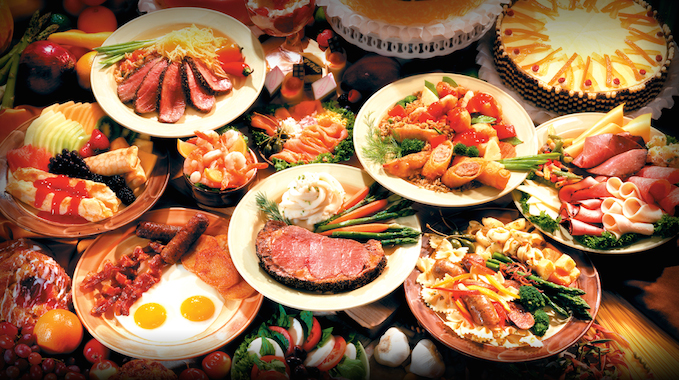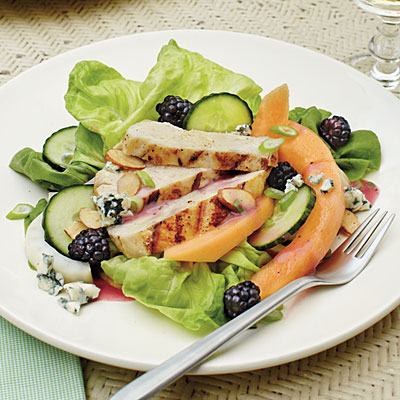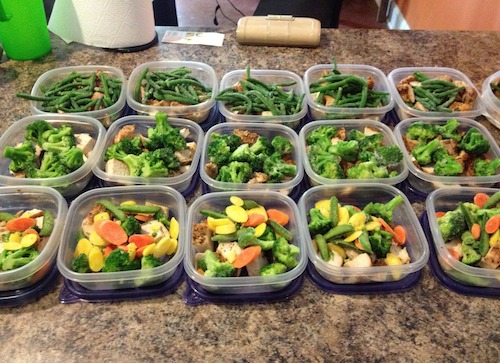Eat Big And Lose Weight With Intermittent Fasting

I love to eat. To me, food is one of the greatest pleasures in life.
You see, I grew up in a big Italian family, and every Sunday we would get together for a massive feast. We’d start with a nearly endless array of appetizers which included fresh mozzarella and tomato, stuffed breads, olives, reggiano cheese, mini quiches, roasted peppers, prosciutto, meat pie, rice balls, and a whole lot more.
Then we’d move on to the pasta course, stuffing ourselves with whatever colossal bowl of pasta that my mother or grandmother prepared for us. Now for most normal families, this would be the conclusion of an already gluttonous meal, with perhaps some fruit or a slice of cake to finish it off.
But not for us. Oh no. We were just getting started.
After the pasta course was over, we’d take about an hour to relax, enjoy each other’s company, and sometimes pass out on the couch for a little while. The first two courses were just a warm-up, and this hour reprieve from eating was essential in order for us to fully appreciate the feast to come.
When it was time for the main course, despite how many times I had already been through this weekly feasting ritual, I could not help but be amazed by the sheer amount of food on the table.
Rack of lamb persillade. Lobster macaroni and cheese. Lemon roasted chicken. Stuffed artichokes. Mashed potatoes. Roasted asparagus. The list goes on and on.
I’ll spare you the description of the typical round of desserts we’d usually have because that would just be cruel, and I think it’s time to finally get to my point, which is this:
Food has been a huge part of my life, and eating large, delicious meals is one of my favorite things to do. But the desire for big muscles and six pack abs almost ruined this passion of mine.
Almost.
Six Unsatisfying Small Meals Per Day. Really?
If you’ve done any reading in the last decade about eating to build muscle, chances are that you’ve come across the standard bodybuilding recommendation of eating six small meals per day.
Here’s a great example of this kind of advice from Mike Roussell of Men’s Fitness:
“EAT SIX TIMES A DAY. Fuel your body with multiple small meals and snacks each day to keep your blood sugar levels under control and your metabolism steady and to stimulate the production of new muscle.”
Sounds good in theory. But what happens when you try to put a plan like this into practice?
Let’s take an average 180 lb guy who needs to eat around 2200 calories per day to lose weight. 2200 divided by 6 is approximately 367 calories per meal. Do you know what you get for 367 calories? A meal that looks like this:

A little bit of chicken, a little bit of fruit, a few veggies. Sure, it looks pretty, but let’s be honest: this meal isn’t going to get anybody excited. It’s small, and you would be done eating it before you know it. And then soon after, you’d be hungry again, waiting for the hours to pass until you can have your next small meal.
Then there’s the hassle of preparing all of these meals. Most of us have to work every day, and food prep is just not realistically going to fit in to our schedules. Do you have the time to do this?

Me neither.
Don’t get me wrong, it’s perfectly OK to prepare your meals like this. I always admire people who show this level of dedication to their pursuits.
But is a six meals per day protocol necessary if you want to build muscle or lose fat? Do you need to keep your metabolism “fired up” all day to lose weight effectively? And do you really need to be getting protein every 2-3 hours to prevent your muscles from breaking down?
Thankfully, the answer to all of these questions is no.
This study from the School of Human Kinetics tested the relationship between meal frequency and weight loss. The results show that eating more meals per day didn’t improve weight loss results for the subjects of the study. All that mattered was that the subjects were under the same caloric deficit – the change in meal frequency made no difference. Several other studies on weight loss and meal frequency corroborate these results.
What about muscle breakdown? Don’t you need to eat every 2-3 hours in order to prevent your body from burning muscle for energy?
Not at all. Your body absorbs protein and other macronutrients at a very slow rate. After a large meal, amino acids slowly trickle into the bloodstream for several hours. In fact, most whole food proteins are absorbed at a rate of only 3-6 grams per hour. If you consume a meal with 60 g of protein, it will take your body at least 10-20 hours to absorb it. The important thing is to make sure you’re getting enough protein, but it doesn’t need to be spread out throughout the day.
So because meal frequency isn’t really a necessary factor when it comes to either building muscle or losing fat, we can use this knowledge to have a little fun when planning our diets. And that’s where intermittent fasting comes in.
Enter Intermittent Fasting. Lose Weight Eating Massive Meals.
Intermittent fasting is a concept that has been around for a while, but really gained popularity in the bodybuilding community over the last few years because of a man named Martin Berkhan and his website LeanGains.
The basic idea is that you fast for a set period of time before you eat again, and in doing so, it makes it easier to put your body into a caloric deficit and lose weight.
There are many different types of intermittent fasting protocols. Some people choose to fast for one entire day each week. Others choose a set schedule for fasting on a daily basis. In Martin Berkhan’s LeanGains, you fast for 16 hours, say from 9pm – 1pm, and then eat within the 8-hour window from 1pm – 9pm.
So basically, with a LeanGains-style approach, you’re just skipping breakfast and any snacks you may have in the morning, choosing to eat only in the afternoon and evening. For many people, this means eating only 2-3 meals per day.
Let’s go back to our example of the guy who needs to eat 2200 calories per day to lose weight, but now, instead of having him eat 6 small meals per day, he’s going to be eating only lunch, dinner, and a small snack. Because he’s fasting in the mornings and splitting up the majority of his calories between 2 meals, he can now eat 1000 calories for lunch and 1000 calories for dinner, along with a 200 calorie snack mid-afternoon.
In other words, he gets to eat 2 huge meals per day where he is legitimately satisfied, even stuffed. 1000 calorie meals are huge, and you certainly won’t be leaving the table hungry after finishing one.
I’ve been following a protocol like this myself to cut my body fat down to 7% for the summer. Here’s one of my favorite cutting meals that I eat about twice a week:

This meal consists of:
- 6 oz chicken breast
- 2 cups of penne pasta with tomato sauce
- 2 large pieces of Italian bread
Yes, I consume a large amount of chicken, pasta, and bread on a regular basis in order to lose weight. I know it sounds crazy, but I can attest to the results. It works, and it makes cutting a helluva lot more fun.
Despite what you may think, intermittent fasting isn’t difficult in the slightest. When I tell people that I never eat breakfast, most of them ask how I’m able to go so long without eating. The truth is that I barely even notice. Sure, the first week was a little tough as my body adjusted, but once I got used to eating fewer meals, fasting in the morning became a piece of cake. In fact, I greatly prefer it. I love waking up in the morning and getting into my routine without having to think about what I’m eating. I can just jump right into my day and not even think about food until lunchtime.
Hacking Your Diet To Stay Lean
Intermittent fasting opens up an entirely new world of creative meal planning. You’re essentially hacking your diet so you can eat huge meals while still losing weight.
Do you enjoy big meals like I do? Adjust your schedule to eat only twice per day, skipping breakfast and consuming the majority of your calories at lunch and dinner.
Have a big family barbecue to attend during the day, but don’t want to ruin your diet? Don’t eat until the barbecue and consume the majority of your daily calories at the event. You’ll be able to eat burgers and hot dogs like everyone else, have a couple beers, and enjoy yourself freely, knowing that you’re not hurting your weight loss efforts. If the barbecue ends early and you’re hungry later that evening, just consume a small meal of protein and vegetables, and get back to your regular diet the next day.
What about if you have dinner plans and you’re going out for a big meal in the evening? Simple. Consume only protein and vegetables throughout the day, say 500 calories worth, and then go out and enjoy your dinner.
The same concepts apply for any type of social gathering, work event, or holiday. You can adjust your meal frequency to shift the majority of your calories in any given day to fit your schedule.
A Word Of Warning
I’ve made this point many times before, but let me stress it again here:
Losing weight, maintaining weight, or gaining weight is all about the total amount of calories you consume.
Even if you’re following an intermittent fasting protocol, you don’t get a license to eat however much you want because you’re only eating 1 or 2 meals per day. You can most definitely gain weight eating only once or twice a day, so make sure to keep an eye on your food intake. This especially becomes a problem when you choose to eat heavily processed junk food, which is heavy on calories and very light on nutritional value.
That’s why, for the best results, I recommend tracking your food intake using an online food journal like FatSecret or MyFitnessPal. Even if you don’t want to do this every day, it’s incredibly helpful to track your food intake for at least a week so you can start to see for yourself how many calories you’re actually consuming vs how many you think you’re consuming.
Conclusion
Adjusting your meal frequency and incorporating periods of intermittent fasting allows you to eat much larger meals while still maintaining a caloric deficit. While this may not be preferable to everyone, I happen to love it, because I can eat until I’m full and satisfied.
Just keep an eye on your caloric intake and make sure that you’re not going over your daily requirement. Remember, losing weight is all about maintaining a caloric deficit. Get enough protein, eat the right number of calories, and plan your meals in a way that works best for your lifestyle.